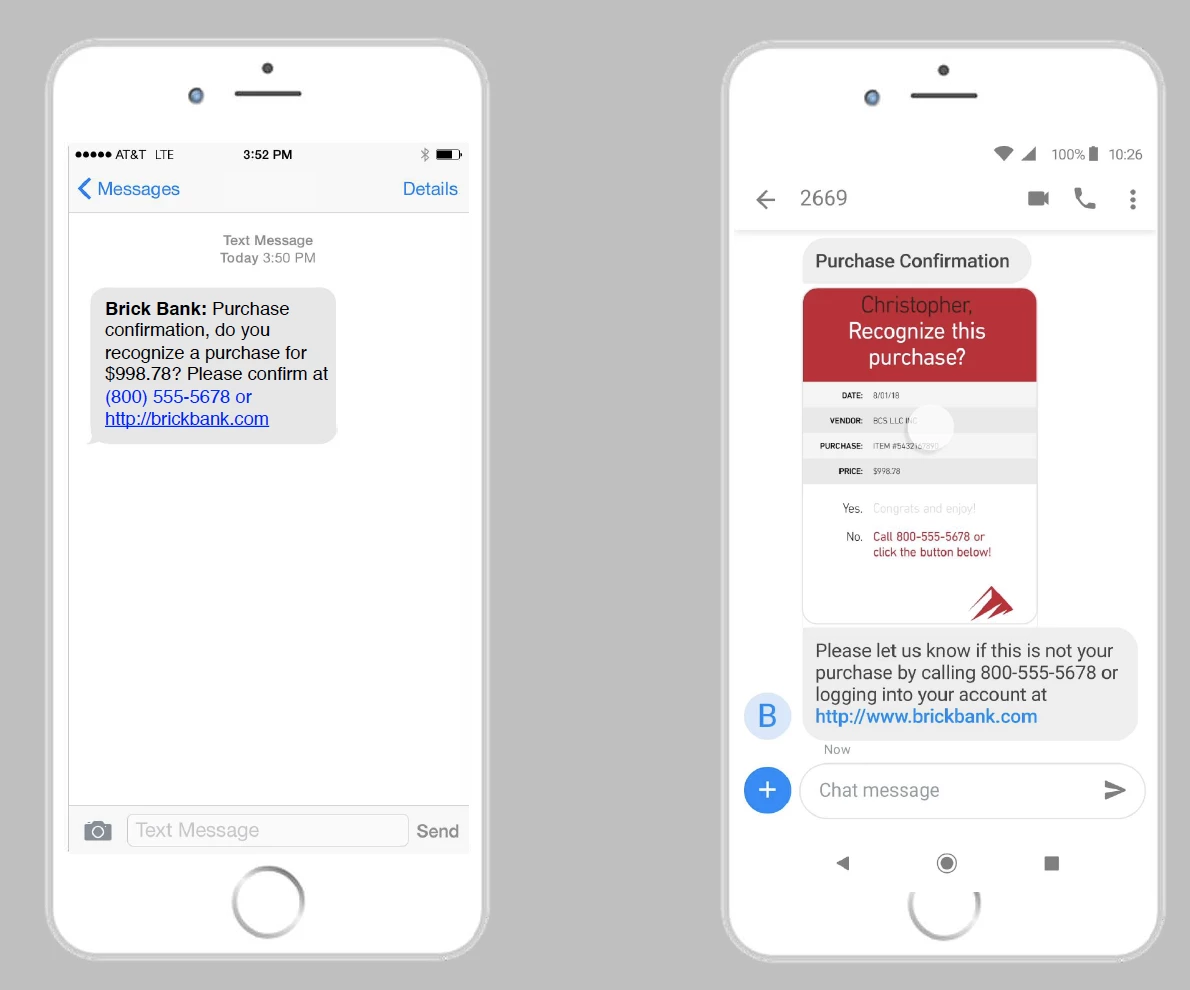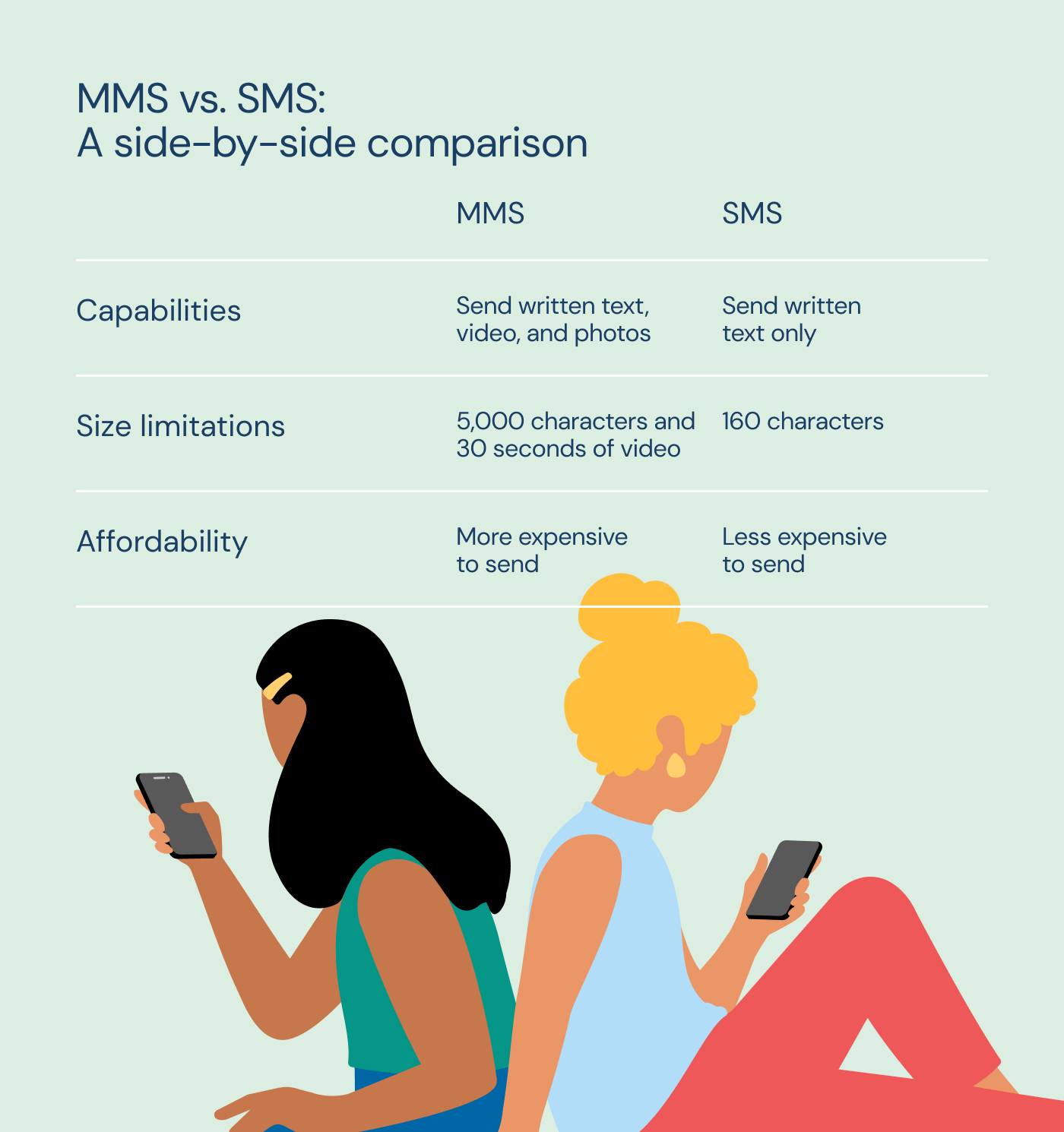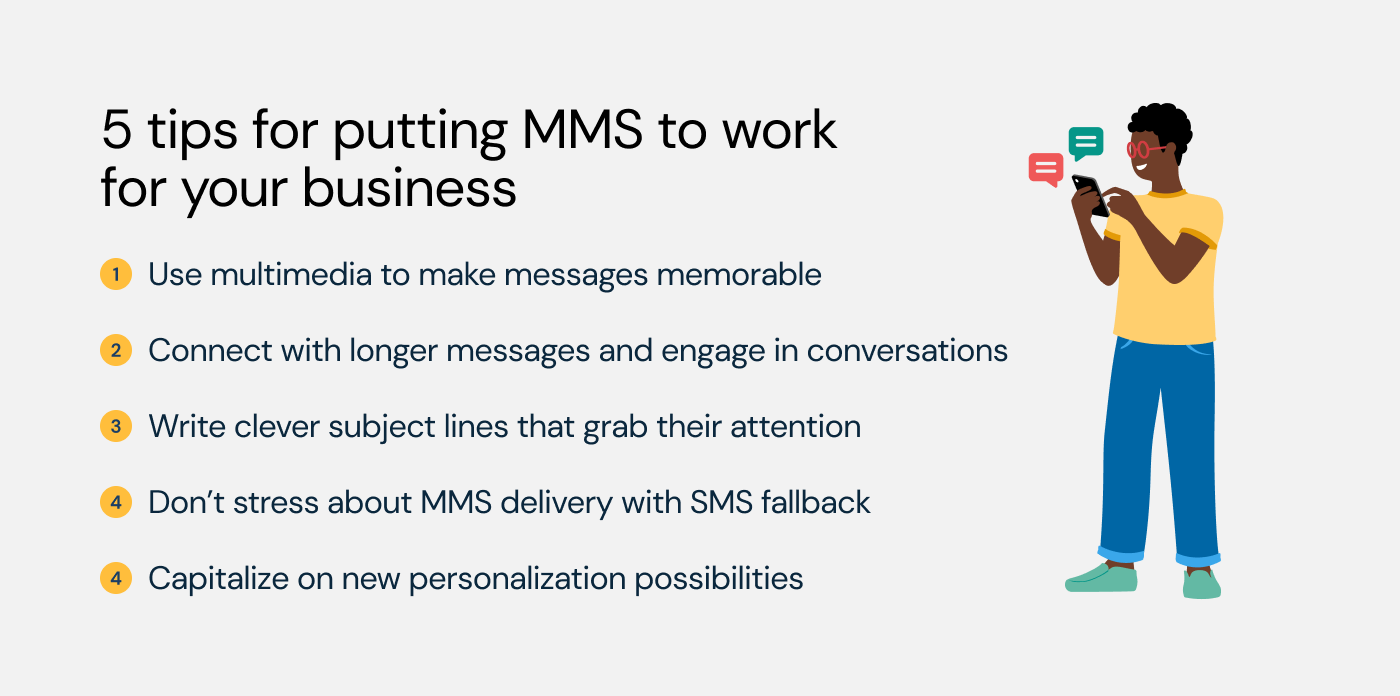Insights
What is MMS messaging? And how is it different from SMS?

Insights

Text messaging has evolved a lot since the first one was sent 30 years ago. And MMS messaging has been a significant advancement in this domain, allowing users to send multimedia content like images, videos, and audio clips alongside text. But what exactly sets MMS texting apart from its predecessor, SMS? Do you know the difference?
MMS and SMS are texting technologies that are quite similar at first glance. But they have some key differences that set them apart. Here we will define what MMS is, we’ll compare the two, detail the ways MMS messaging can support your business goals, and show you some examples of popular use cases.
MMS is an abbreviation for Multimedia Messaging Service. As you may have guessed from the word “multimedia,” MMS messages are capable of incorporating images, video, and audio files. That includes all of the texts we send or receive that contain emojis and website links.
And considering that 90% of people open a text message within three minutes of receiving it, this media-rich form of communication creates great opportunities for businesses to reach and engage both existing and potential customers.

SMS and MMS messages offer different capabilities, depending on your business’ needs. Let’s dive into some of the similarities and differences of these two messaging channels.
SMS is the common acronym for Short Message Service. It’s the most widely used (and one of the oldest) texting technologies in the world and is limited to just text.
SMS and MMS have different features and reach that can enhance messaging between a brand and its customers. When used together, they can enhance a brand’s reach and engagement.
The biggest difference between MMS vs SMS is that MMS allows you to include rich media files such as images, GIFs, and videos. MMS can send up to 500 KB of data (up to 1,600 characters) and up to 30 seconds of video or audio. Depending on your messaging provider, MMS messages typically cost more to send than SMS messages.
Watch Lodema Steinbach, VP of Product and Carrier Relationships at Sinch, show how the power of picture messages and MMS can drive customers to take action.
SMS messages are restricted to text (which includes links) and are further limited to just 160 characters. Because of their simplicity, SMS are generally cheaper to send and more widely available than MMS. Rates for sending bulk messages of either type vary by provider, as do capabilities and rates for sending MMS and SMS messages internationally.
For marketing teams, MMS marketing is frequently used by businesses to increase engagement and boost sign-ups with multimedia content. Meanwhile, SMS marketing is a more affordable and scalable option for businesses with a wide or global reach.
MMS and SMS do have some things in common, which leads many people to mistakenly use the acronyms interchangeably.
They were built using the same base technology – MMS was initially created so SMS users could send multimedia files. And both MMS and SMS are delivered over a cellular network, which means recipients need a mobile device with a text messaging plan to receive them.
Generally, MMS messages will cost more to send than SMS messages due to the larger amounts of data being transmitted. However, specifics will depend on your messaging provider.
So when deciding on whether to use MMS messaging, you have to weigh the benefits against the costs. MMS messaging usually has higher engagement and opt-in rates than SMS, which could result in more click-throughs, sales, and revenue.
Will that be enough to justify the higher costs? You’ll have to try it and study your data to know for sure.

Some people may confuse SMS, MMS, iMessage, WhatsApp, and other channels because they all involve mobile messaging, but each channel is actually quite different!
A key difference between SMS and MMS and other channels is that both SMS and MMS rely on a mobile network infrastructure, meaning that a user can receive messages on their mobile devices without a data plan.
Meanwhile, Over-The-Top (OTT) messaging services like WhatsApp and iMessage (via Apple Messages for Business) rely on a cellular network connection for communication. These channels offer feature-rich messaging experiences like voice and video calling, group messaging, buttons, product catalogues, gifs, and other multimedia sharing that aren’t readily available with SMS or MMS.
SMS and MMS reach 100% of users with a cell phone, while these OTT messaging services have a more limited reach:
Another difference between these services is the charges associated with them. SMS and MMS often incur charges per message sent or received. OTT channels on the other hand need an internet connection, making them more cost-effective.
|
SMS |
MMS |
iMessage |
| |
|---|---|---|---|---|
|
Reach | 100% of mobile phone users (7.4 billion people) | 100% of mobile phone users | iOS (Apple) users (1.8 billion users) | WhatsApp users (2 billion active users) |
|
Connectivity |
| Rely on mobile network, so users can receive messages without a data plan | Rely on cell network or WiFi, so users need a cellular data plan and an app to receive messages | Rely on cell network or WiFi, so users need a cellular data plan and an app to receive messages |
| Capabilities | Written text (160 characters) | Written text, videos, pdfs, audio files, and photos | Written text, videos, photos, voice and video calling, group messaging, gifs, product catalogues, and other multimedia sharing | Written text, videos, photos, voice and video calling, group messaging, gifs, product catalogues, and other multimedia sharing |
Research shows the engagement rate for text messages is 20 times higher than for emails, making MMS messaging a powerful tool for connecting with customers. Our 2024 survey of several hundred U.S. consumers also revealed that that they want to hear about promotions as often as they’re available, making mobile communication a fast, easy, and effective way to build customer loyalty.
Both SMS and MMS allow you to reach customers instantly on the devices that are probably already in their hands. Of course, MMS specifically offers some advantages worth considering depending on the campaign or marketing strategy you plan to use.
From higher open rates to personalized experiences that maximize conversions and sales, there are many benefits of MMS messaging. Here are a few tips to make your messages as effective as possible.
Images add color and depth to the messaging you share with customers. The option to use images, videos, and GIFs can make your MMS message more visually exciting compared to a simple SMS text.
In fact, scientists have found that when people hear information, they will most likely only retain about 10% of that information three days later. But when a relevant image is paired with that same messaging, recipients remembered 65% of the information after three days.
SMS texts are limited to 160 characters, which can potentially create challenges for developing a message that actually connects with your audience. MMS messages provide an opportunity to craft more detailed messages of up to 5,000 characters. And adding images, videos, or audio files gives you even greater capacity to inform and engage.
Support for two-way messaging means MMS isn’t simply the equivalent of a personalized pocket billboard – it can help you reduce friction in the customer experience and improve overall customer satisfaction.
During Email Camp 2024, Alfredo Salkeld of Sinch SimpleTexting hosted a session that included creative ideas for how businesses to stand out with SMS marketing. As part of his advice to brands, he stressed the importance of using two-way SMS and MMS messaging to build relationships.
“Pretty much every major brand is starting to take advantage of texting. And the ones doing it well are using it as a two-way channel, interacting with customers and not just sending out one-way information.”

Say you text picture proof of a delivery to a customer and they don’t recognize the location. They can immediately text back to tell the driver it looks like the wrong address. The driver then corrects the error while he’s nearby. Problem avoided and your company earned the trust of a now fiercely loyal customer.
MMS messages can also include subject lines, which not only creates a unique opportunity to spark an emotional connection with the consumer but also makes them more likely to open your text.
Getting the subject line right can definitely drive higher MMS open rates, so make sure you’re applying best practices when crafting subject lines for text messages. Higher open rates for the win!
Google’s data scientists report that 90% of leading marketers say personalization is a major contributor to building a profitable business. MMS messaging gives you the ability to deliver even more engaging personalization via text message.
MMS messaging gives you the ability to deliver even more engaging personalization via text message. With the option to add images and short videos, you can get hyper creative with sending personalized MMS.
You may have a mobile number to text, but there’s no way to tell if the person’s device is MMS-enabled ahead of time.
Don’t worry, if an MMS message can’t be delivered, they’ll still get an SMS fallback message. This fallback message has a dynamic URL to the original multimedia message you sent and ensures your communications are always received as you intended.

Marketers lead the way in using MMS to increase reach, conversions, and sales with their captivating multimedia campaigns that feature powerful calls-to-action, and they’ve got the ROI to show it. But MMS messaging isn’t just for creative marketing campaigns – it’s an essential channel for customer engagement that can help transform your entire customer experience.
For the customer-obsessed leader in any business, two-way multimedia messaging can offer simple solutions for reducing churn and improving customer loyalty.
Let’s take a look at a few common use cases for MMS messaging.
Mobile marketing in retail isn’t just about sending promotional messages; it’s about building stronger relationships, enhancing customer engagement and, ultimately, driving profits.

MMS messaging can be deployed to engage and inspire action in welcome or onboarding texts, new product promotions, Black Friday deals, rewards notifications, abandoned cart reminders, and more.
Because MMS can include visual elements like location images, it can be a helpful tool to provide visual confirmation of appointment times or deliveries.
Plus, MMS allows for a longer character limit than SMS. That means you can provide more detailed information about the appointment, like a map, additional instructions, or special requirements for your customer to remember.
Relationships between brands and consumers don’t end with a purchase.
With MMS, you can send high-quality product images, promotional videos, or interactive elements to showcase products or services that you know are super relevant to your target audience.

MMS allows for high-resolution images, graphics, and videos in messages, which can help you grab your audience’s attention and make an offer or brochure more enticing.
Bonus: Check out this guide of promotional text message examples for inspiration for your next campaign!
With MMS, banks can deliver timely messages to notify customers about potentially fraudulent activities having to do with an account or transaction.
Brands can use MMS to send payment confirmations that include important details like any reference, account, or confirmation numbers. This can be reassuring to a customer to help them keep track of payments and have a record for future reference.
Plus, digital text receipts eliminate the need for a customer to have a physical copy, making their life a little easier if they need to get in contact with you about something they’ve purchased!
With MMS, there is seemingly endless potential to engage and have a conversation with your audience. We’ve only scratched the surface on MMS messaging, so be sure to check out the resources below before you go!
Understanding what MMS messaging is and how useful it can be for marketing and customer experience is critical to success in the modern business world.
MMS is just one important channel that can be a part of a business’ conversational messaging strategy. Check out these resources as you explore other conversational messaging channels and tools:
Or, for a full overview of each conversational channel and how you can use them to reach your customers, download “The ultimate guide to conversational messaging.”
You can also check out our MMS Knowledge Base for more information. Or, if you’re ready to talk all things MMS, let’s chat. We’ll help you create eye-catching messages that your customers can’t ignore.